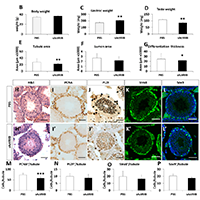Inhibition of Activin/Myostatin signalling induces skeletal muscle hypertrophy but impairs mouse testicular development

HTML: 26
All claims expressed in this article are solely those of the authors and do not necessarily represent those of their affiliated organizations, or those of the publisher, the editors and the reviewers. Any product that may be evaluated in this article or claim that may be made by its manufacturer is not guaranteed or endorsed by the publisher.
Authors
Numerous approaches are being developed to promote post-natal muscle growth based on attenuating Myostatin/Activin signalling for clinical uses such as the treatment neuromuscular diseases, cancer cachexia and sarcopenia. However there have been concerns about the effects of inhibiting Activin on tissues other than skeletal muscle. We intraperitoneally injected mice with the Activin ligand trap, sActRIIB, in young, adult and a progeric mouse model. Treatment at any stage in the life of the mouse rapidly increased muscle mass. However at all stages of life the treatment decreased the weights of the testis. Not only were the testis smaller, but they contained fewer sperm compared to untreated mice. We found that the hypertrophic muscle phenotype was lost after the cessation of sActRIIB treatment but abnormal testis phenotype persisted. In summary, attenuation of Myostatin/Activin signalling inhibited testis development. Future use of molecules based on a similar mode of action to promote muscle growth should be carefully profiled for adverse side-effects on the testis. However the effectiveness of sActRIIB as a modulator of Activin function provides a possible therapeutic strategy to alleviate testicular seminoma development.
-
-
-
How to Cite
PAGEPress has chosen to apply the Creative Commons Attribution NonCommercial 4.0 International License (CC BY-NC 4.0) to all manuscripts to be published.

 https://doi.org/10.4081/ejtm.2019.8737
https://doi.org/10.4081/ejtm.2019.8737



